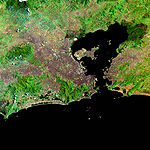Jornal do Brasil
1891 establishments in Brazil2010 disestablishments in BrazilDaily newspapers published in BrazilDefunct newspapers published in BrazilMass media in Rio de Janeiro (city) ... and 4 more
Newspapers established in 1891Online newspapers with defunct print editionsPortuguese-language newspapersPublications disestablished in 2010

Jornal do Brasil, widely known as JB, is a daily newspaper published by Editora JB in Rio de Janeiro, Brazil. The paper was founded in 1891 and is the third oldest extant Brazilian paper, after the Diário de Pernambuco and O Estado de S. Paulo. On 31 August 2010 it became a digital newspaper, folding its print edition until 25 February 2018, when it was printed again.
Excerpt from the Wikipedia article Jornal do Brasil (License: CC BY-SA 3.0, Authors, Images).Jornal do Brasil
Avenida Brasil, Rio de Janeiro São Cristóvão
Geographical coordinates (GPS) Address Phone number Website Nearby Places Show on map
Geographical coordinates (GPS)
| Latitude | Longitude |
|---|---|
| N -22.89393 ° | E -43.21522 ° |
Address
Instituto Nacional de Traumatologia e Ortopedia
Avenida Brasil 500
20940-070 Rio de Janeiro, São Cristóvão
Rio de Janeiro, Brazil
Open on Google Maps








